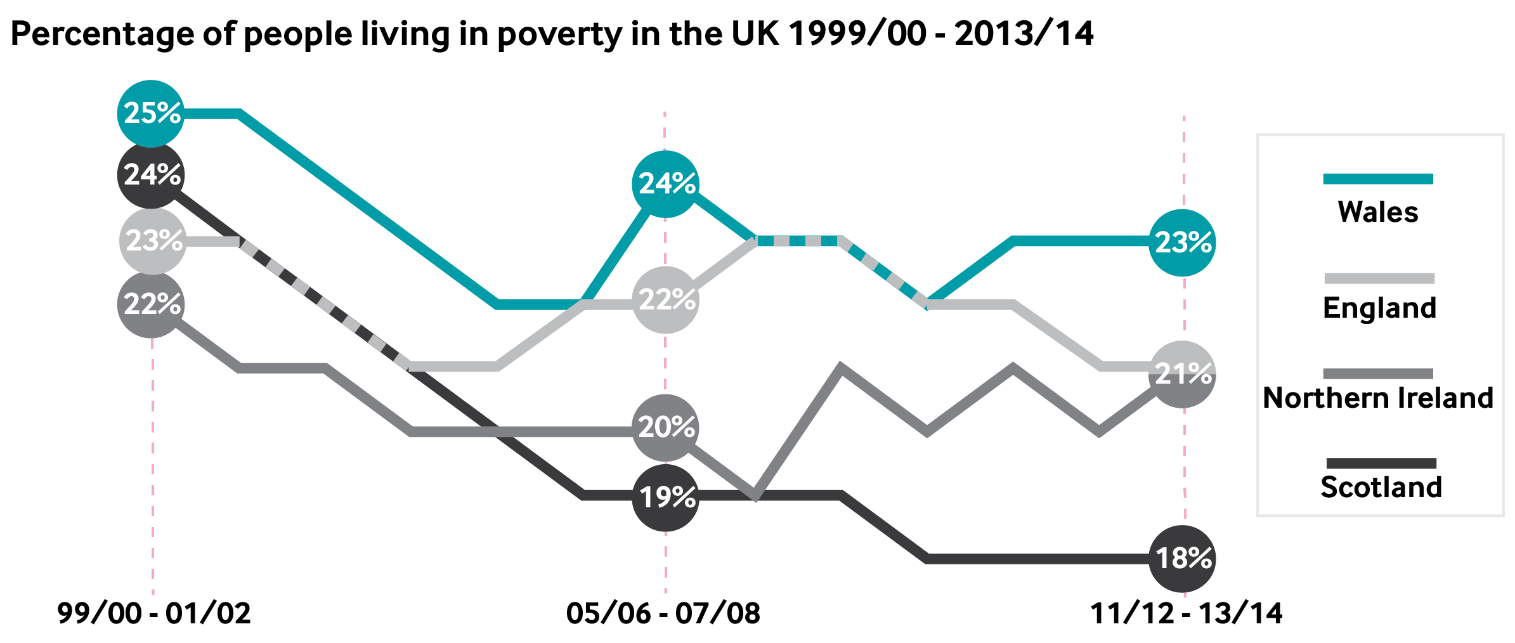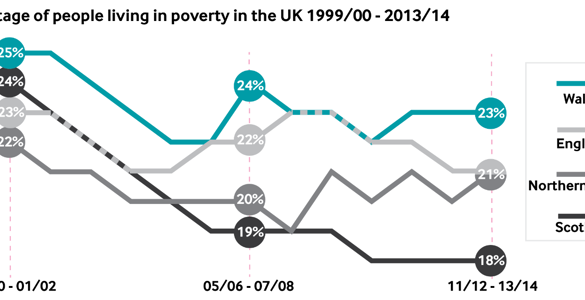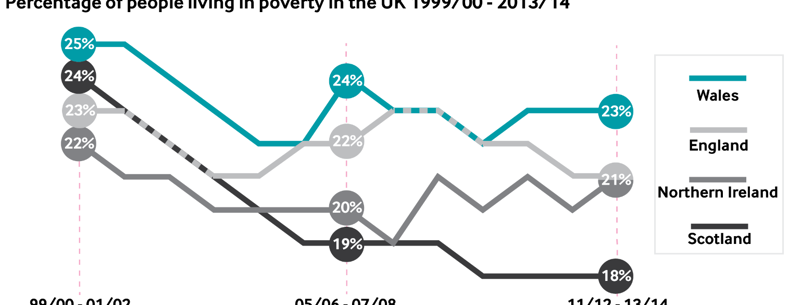Article by Hannah Johnson and Gareth Thomas, National Assembly for Wales Research Service
This article is taken from ‘Key issues for the Fifth Assembly’, published on 12 May 2016.
With rising in-work poverty and further welfare reforms on the horizon, what will low income look like in the Fifth Assembly?
Nearly a quarter of the Welsh population live below the poverty line. This means that 700,000 people of all ages – 23% of the country – live in families with weekly incomes of £232 or less. Wales has the highest poverty rate in the UK. Levels have been relatively static for ten years, but the profile of who is living in poverty has changed. Pensioners are far less likely to be poor than they were ten years ago, with poverty rates dropping from 23% to 14%. Child poverty has stayed the same at 31%, but this is lower than in 2000 when it was 36%. But working families and young people in Wales are at greater risk of poverty now than they were a decade ago.
What is poverty?
A person is considered to be in poverty if their household income falls below 60% of the UK median (which is the middle value in the list of numbers.)
The median weekly household income in the UK is around £386 after housing costs, and 60% of this is £232.

Why are working people living in poverty?
Is getting a job the best route out of poverty? We have record high employment levels, and a record low percentage of out-of-work households in Wales. At the same time, in-work poverty has risen. How will this affect the design of anti-poverty and job creation programmes in the future? Working patterns have a huge impact on the risk of poverty. Increases in in-work poverty are almost entirely in ‘part-working’ families (which are households where people work part time, are self-employed or have one full time worker and one adult not working). Around 100,000 more people in part-working families are in poverty than a decade ago. In families where all the adults are in work, there was no increase during the same period. The high proportion of low paid jobs in Wales (which are jobs that pay below two‑thirds of the UK median hourly wage) is key to these findings. A quarter of jobs in Wales are low paid – the same proportion as ten years ago. This rises to 45% of all part time jobs, which are mainly held by women. The balance between part time and full time work has shifted in recent years, with just under 30,000 more people in Wales working part time now compared with the start of the 2008 recession. Zero hour contracts are seen by some as synonymous with insecure work, and almost 50,000 people in Wales were on such contracts at the end of 2015. On top of this, 31% of working-age adults are not in employment at all. For women, this figure is slightly higher at 34%. For ethnic minority groups it is 45%, and for disabled people it is 55%.
Will welfare reforms increase poverty in Wales?
Wales is more reliant on welfare than other countries in the UK, so cuts made to in-work and out-of-work benefits have a greater impact. Average incomes are below the UK average, so benefit reductions are likely to represent a larger percentage of net income. There are arguably three welfare reform measures that are having, or will have, the greatest impact on the income levels of families in Wales in the Fifth Assembly:
- the housing benefit social housing under-occupation measure (also called the ‘bedroom tax’ or ‘removal of the spare room subsidy’), which currently affects around 30,000 people in Wales, with an average weekly reduction of £14 per person;
- universal credit, which will replace certain benefits and tax credits. The rollout is in progress and is expected to be completed by 2021. In Wales, universal credit is forecast to increase the incomes of working households with children, and reduce the incomes of households with no one in paid work; and
- the replacement of disability living allowance (DLA) with the personal independence payment (PIP). This includes a tightening of the assessment criteria, and a reduction in the number of eligible claimants. More than one in five working age people in Wales is disabled – one of the highest proportions in the UK.
What next?
Welsh households are more dependent on benefits, compared with the UK average. They are likely to see further reductions in their income over the next five years as a swathe of new reforms is implemented. Low paid, unstable and part time work are key causes of poverty in Wales, with ar ound 100,000 more people in Wales experiencing in-work poverty than ten years ago. Will these families feel the benefit of the new UK National Living Wage or future Welsh Government anti-poverty measures, or will they be out-weighed by cuts? The challenge for the new Welsh Government is how to reduce poverty when power over the primary levers of influence such as tax, employment law and benefits, do not lie in Wales.
Key sources
- Department for Work and Pensions, Households below average income: 1994/1995 to 2013/2014
- Joseph Rowntree Foundation, Monitoring poverty and social exclusion in Wales (2015)
- Institute of Fiscal Studies, The impact of the UK Government's tax, welfare and minimum wage reforms in Wales (2015)
- StatsWales, ILO unemployment rate and Persons employed






